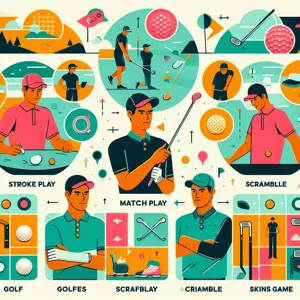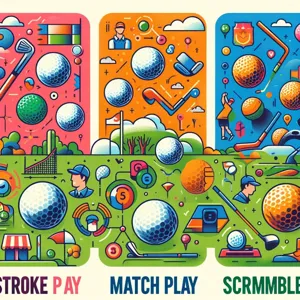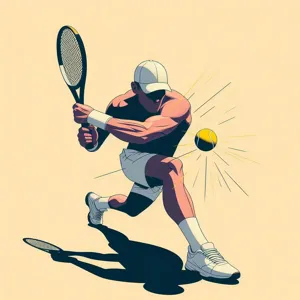Golf tournaments are more than just a display of skill; they embody the spirit of competition, camaraderie, and the love of the game, drawing players and fans alike into a world of precision and strategy.
Whether you’re an aspiring golfer looking to participate or a passionate enthusiast wanting to deepen your understanding of the sport, navigating the various types of golf tournaments can be both exciting and overwhelming. From the prestigious majors that showcase the finest talent in the world to local charity events that foster community spirit, each tournament has its unique flair and format. In this ultimate guide, we’ll explore the diverse landscape of golf tournaments, breaking down the rules, structures, and nuances of each type. Join us as we delve into the fairway and discover what makes each tournament special, ensuring you’re well-equipped to appreciate or participate in the thrilling world of golf!
1. Introduction to Golf Tournaments

Golf tournaments are more than just a test of skill; they are vibrant celebrations of the sport that bring together players of all levels, from amateurs to seasoned professionals. Whether held on sprawling country clubs or local municipal courses, these events create a unique atmosphere filled with camaraderie, competition, and excitement. For many, participating in a tournament is a rite of passage, a chance to showcase their talent, improve their game, and bond with fellow golf enthusiasts.
At their core, golf tournaments can be categorized in numerous ways, each offering its own set of rules, formats, and challenges. From traditional stroke play events where every shot counts to the more relaxed ambiance of scramble formats that encourage teamwork, there’s a tournament style to suit every golfer’s preference. Additionally, tournaments can vary in scale—from local club championships to prestigious international competitions that draw crowds and media attention from around the globe.
Understanding the different types of golf tournaments not only enhances your appreciation for the sport but also informs your participation and strategy. As we delve into this guide, we will explore the nuances of various tournament formats, the significance of amateur events versus professional showcases, and how participating in these tournaments can elevate your game and enrich your experience on the course. Whether you’re a newcomer looking to enter your first tournament or a seasoned player seeking to broaden your horizon, this guide aims to equip you with the knowledge you need to navigate the exciting world of golf tournaments with confidence and enthusiasm.
2. The Importance of Golf Tournaments in the Sport
Golf tournaments play a pivotal role in the world of golf, serving as both competitive stages and community-building events that elevate the sport’s profile. They are not just mere competitions; they are celebrations of skill, strategy, and sportsmanship that attract players and spectators alike. Whether it’s a serene local club tournament or a grand-scale championship like The Masters, these events foster a sense of camaraderie among participants and encourage a healthy competitive spirit.
At their core, golf tournaments provide players with invaluable opportunities to showcase their talent. For amateurs, they offer a chance to gain experience, improve their game, and test their skills against peers. For professionals, tournaments are a platform to earn recognition, secure sponsorships, and vie for lucrative prizes. The pressure of competing in front of spectators and onlookers can be exhilarating, pushing players to perform at their peak and often leading to unforgettable moments on the green.
Moreover, golf tournaments contribute significantly to the growth and popularity of the sport. They draw in enthusiasts from various backgrounds, creating a vibrant atmosphere that promotes networking and social interaction. Spectators enjoy the excitement of live play, while sponsors and brands leverage these events to market their products to a captive audience. This symbiotic relationship between tournaments and the golfing community fosters a thriving ecosystem that benefits everyone involved.
In addition to competition and engagement, many tournaments also have philanthropic components, raising funds for charities and community projects. This charitable aspect can transform a simple round of golf into a powerful tool for positive change, making tournaments not only a testament to skill but also a means to give back to society.
In essence, golf tournaments are the heartbeat of the sport, intertwining competition, community, and charity. They enhance player development, boost engagement, and promote the rich culture of golf, ensuring that the sport remains vibrant and dynamic for generations to come.
3. Types of Golf Tournaments: An Overview

When it comes to the world of golf, tournaments serve as the heartbeat of the sport, providing competitive opportunities and fostering camaraderie among players. Understanding the various types of golf tournaments is essential for both players and spectators alike, as each format offers a unique experience and set of challenges.
**Stroke Play** is perhaps the most traditional and widely recognized format. In this tournament style, each golfer competes to complete the course in the fewest number of strokes. The player with the lowest total score at the end of the round is declared the winner. This format is often seen in major championships, making it the gold standard in competitive golf.
**Match Play**, on the other hand, is a head-to-head competition where players face off, hole by hole. In this format, the goal is to win more holes than your opponent rather than focusing on the overall score. This creates a dynamic and strategic environment, as players must adapt their strategies based on their opponent’s performance. The excitement of match play often leads to thrilling finishes, as every hole can shift the momentum of the match.
**Scramble** tournaments bring a more casual, team-oriented approach to the game. In a scramble, each player on a team tees off, and the team then selects the best shot to play from. This process continues until the ball is holed out. Scrambles are ideal for players of varying skill levels, as they encourage teamwork and often result in lower scores, making the day enjoyable for everyone involved.
**Stableford** scoring is another unique format that emphasizes points over strokes. Players earn points based on their performance on each hole, with higher scores awarded for better performance. This format encourages aggressive play, as players can still earn points even if they don’t finish the hole in the fewest strokes.
Finally, there are **Pro-Am** tournaments, which pair amateur golfers with professional players. This format not only offers amateurs an unforgettable experience sharing the course with pros, but it also creates an engaging atmosphere for spectators, blending skill levels and personalities.
Each tournament type offers its own flavor and challenges, making golf not only a game of skill but also one of strategy and sportsmanship. Whether you’re a participant or a fan, understanding these various formats will enhance your appreciation of the sport and the excitement that each tournament brings.
4. Stroke Play vs. Match Play: Key Differences
When it comes to golf tournaments, understanding the difference between stroke play and match play is crucial for both players and spectators alike. These two formats not only influence the strategy and mindset of the golfers but also shape the overall experience of the tournament.
**Stroke Play** is the most common format and is widely used in professional tournaments, including the prestigious Masters and U.S. Open. In stroke play, players compete over a set number of holes, and the goal is simple: complete the course in the fewest strokes possible. Each stroke is counted, and at the end of the round, the player with the lowest total score emerges victorious. This format emphasizes consistency and endurance, as players must maintain their focus and performance over all 18 holes. It also opens the door for dramatic comebacks, as a single bad hole can be offset by a series of strong performances.
On the other hand, **Match Play** takes a more head-to-head approach. In this format, two players (or teams) compete against each other over the course of a set number of holes, with the winner of each hole determined by who takes the fewest strokes. The overall winner is the player or team who wins the most holes. This format encourages a different kind of strategy; players may take more risks to win a hole, knowing that one bad hole won’t necessarily eliminate them from the competition. Match play is often seen in events like the Ryder Cup, where the excitement of direct competition and the potential for dramatic swings in momentum add to the thrill of the game.
In summary, while stroke play is about cumulative performance and consistency, match play focuses on the individual battles between competitors, inviting a more tactical and sometimes unpredictable element to the game. Understanding these differences allows players to better prepare for their tournament experiences, tailoring their strategies and mental approaches for the format at hand. Whether you prefer the challenge of stroke play or the excitement of match play, both formats contribute uniquely to the rich tapestry of golf competition.
5. Scramble Tournaments: Team Play Dynamics

Scramble tournaments offer a unique and exhilarating twist to traditional golf, emphasizing teamwork and camaraderie over individual performance. In a scramble, participants form teams, typically consisting of four players, who collaborate to achieve the best possible score on each hole. The format allows players of varying skill levels to come together, making the game more accessible and enjoyable for everyone involved.
The dynamics of a scramble tournament are fascinating. Each player tees off, and the team then selects the best shot among them to play from. This process continues, with players alternating shots until the ball is holed. This format not only encourages strategy and teamwork but also fosters a supportive environment where players can celebrate each other’s strengths. For instance, a long hitter can drive the ball down the fairway, while a more accurate player can finesse their short game to sink the putt.
One of the key benefits of scramble tournaments is the social aspect they promote. Players are often encouraged to communicate, strategize, and share tips, enhancing the overall experience. The pressure is somewhat alleviated, as the focus shifts from personal performance to collective success. This makes scramble tournaments an excellent option for corporate outings, charity events, or casual rounds with friends.
Additionally, many scramble tournaments incorporate fun themes and challenges to keep the atmosphere lively. From themed costumes to unique hole challenges, these elements add an extra layer of enjoyment, making each tournament a memorable occasion.
In conclusion, scramble tournaments are an excellent way to enjoy the game of golf while strengthening bonds between teammates. Whether you’re a seasoned pro or a novice, the team play dynamics of a scramble tournament ensure that everyone can contribute to the team’s success while having a blast on the course.
6. Best Ball Tournaments: How They Work
Best ball tournaments are a popular format in the golfing community, known for their blend of competition and camaraderie. In this format, teams of two or four players compete against each other, with each player playing their own ball throughout the round. However, the magic happens when it comes to scoring: the team’s best individual score on each hole is recorded as the team’s score for that hole. This unique setup not only allows for a more relaxed atmosphere but also encourages players to perform their best, knowing that their teammates are counting on them.
Imagine a sunny Saturday morning on the lush green fairways, with the sound of laughter and friendly banter echoing among players. Each golfer takes their shot, and as they navigate the course, they cheer each other on, hoping for the perfect drive or an impressive putt. The excitement builds as teams strategize, weighing risks against rewards—should a player go for the challenging par five in hopes of achieving an eagle, or should they play it safe to guarantee a more reliable score?
In a best ball tournament, each golfer’s skills shine in different ways, and players of varying skill levels can thrive. Beginners often find themselves paired with more experienced golfers, providing an excellent opportunity for learning and growth. Furthermore, because only the best score counts, even if a player has an off day, the team’s overall performance can still shine, making it a more inclusive and enjoyable experience for all.
As the day unfolds, the competition intensifies. Teams eagerly keep an eye on the leaderboard, calculating their scores and assessing their chances against other groups. With a mix of strategy, teamwork, and individual talent, best ball tournaments foster an environment where relationships are built, and memories are made on and off the course. Whether it’s a friendly outing or a more serious competition, these tournaments highlight the spirit of golf—fun, challenge, and camaraderie.
7. The Format of Alternate Shot Tournaments

Alternate shot tournaments, often known as “Foursomes,” bring a unique twist to the game of golf, adding an element of teamwork and strategy that can elevate the excitement on the course. In this format, two players form a team and take turns hitting the same ball. One player tees off on odd-numbered holes while the other takes the first shot on even-numbered holes, creating a rhythm that requires both strategy and synergy.
This format demands not only skill but also a deep understanding of each other’s playing styles. Team members must communicate effectively, discussing club selection, shot strategy, and the nuances of each hole to maximize their chances of scoring well. The pressure can be palpable, as both players must rely on each other’s abilities and decisions, making every swing a collective effort.
The challenge of alternate shot tournaments lies in their potential for both brilliance and blunders. A single misstep can dramatically affect the team’s score, making accuracy and consistency paramount. Players often find themselves in the unique position of having to adjust their game to complement their partner’s strengths and weaknesses, fostering a deeper connection and camaraderie that can be both rewarding and challenging.
Additionally, these tournaments are typically played over a set number of holes, usually 18, but variations exist, especially in amateur events. Many tournaments also introduce local rules that can affect how the game is played, such as allowing the use of carts or stipulating specific tee boxes.
Ultimately, alternate shot tournaments not only test golfers’ abilities but also highlight the importance of partnership and strategy, making them a thrilling format for both players and spectators alike. Whether you’re an experienced golfer or a newcomer to the sport, participating in an alternate shot tournament can deepen your appreciation for the game and enhance your skills in ways you may never have imagined.
8. Understanding Stableford Scoring System
The Stableford scoring system is a unique approach to golf that encourages aggressive play and rewards consistency, making it a popular format in many amateur tournaments. Unlike traditional stroke play, where the goal is to complete the course in the fewest strokes, Stableford assigns points based on the number of strokes taken relative to par.
In this system, players earn points for each hole based on their score in relation to par: 0 points for a double bogey or worse, 1 point for a bogey, 2 points for par, 3 points for a birdie, 4 points for an eagle, and so on. This means that even if a player has a rough day on the course, they can still accumulate points and remain competitive. The beauty of this format lies in its ability to minimize the impact of a single bad hole, allowing players to focus on their overall performance instead.
The Stableford system also introduces a strategic element to the game. Players are encouraged to take calculated risks, knowing that a birdie can substantially boost their score. This can lead to more exciting play, as competitors push themselves to take on challenging shots in hopes of reaping the rewards.
Understanding how to navigate the Stableford scoring system can enhance your tournament experience, whether you’re a seasoned player or new to the game. As you familiarize yourself with the point structure, you’ll be better equipped to adapt your strategy and approach on the course, ultimately leading to a more enjoyable and competitive outing. So the next time you find yourself in a Stableford event, remember: it’s not just about how many strokes you take, but how well you can accumulate points and make the most of each hole!
9. Major Championship Tournaments: A Closer Look
When it comes to golf, few events command as much respect and attention as the major championship tournaments. These prestigious competitions not only showcase the pinnacle of skill and sportsmanship but also carry a rich history that enhances their allure. There are four major championships that stand out in the golfing world: The Masters, the U.S. Open, The Open Championship (often referred to as the British Open), and the PGA Championship. Each tournament has its unique characteristics, traditions, and challenges that make them special.
**The Masters**, held annually at the iconic Augusta National Golf Club, is perhaps the most revered of the majors. Known for its stunning azaleas and manicured greens, this tournament boasts an exclusive invite-only field, making it a coveted opportunity for golfers. The green jacket awarded to the champion symbolizes not just victory but a place in golfing history. Each year, the tournament heralds the arrival of spring, capturing the hearts of fans around the globe.
**The U.S. Open**, on the other hand, is infamous for its difficulty. Known for its challenging course setups and often unpredictable weather conditions, this tournament tests the mettle of even the most seasoned professionals. The U.S. Golf Association’s commitment to fairness and integrity means that the tournament is open to all qualified players, leading to a diverse and highly competitive field. With its demanding conditions and rigorous qualifying process, the U.S. Open is a true test of skill and resilience.
**The Open Championship**, steeped in tradition, is the oldest of the four majors and is played on the links courses of the British Isles. Its unique coastal courses present challenges like unpredictable winds and deep bunkers, demanding a blend of strategy and adaptability from competitors. The Claret Jug, awarded to the champion, is a symbol of excellence and history, revered by golfers around the world.
Lastly, the **PGA Championship** has evolved into a major that emphasizes the professional golfer’s skill set. Traditionally held in August, this tournament boasts a diverse array of courses, showcasing both traditional and modern designs. The PGA Championship is known for its competitive field, featuring some of the world’s best players, and offers a significant prize purse, making it a critical event in the golf calendar.
In conclusion, major championship tournaments are not just competitions; they are celebrations of the game itself. Each event brings its own flavor, challenges, and stories, contributing to the rich tapestry of golf history. For any golf enthusiast, understanding these tournaments is essential not only for appreciating the sport but also for recognizing the dedication and talent that define the world of professional golf.
10. Local and Regional Tournaments: Community Engagement
Local and regional golf tournaments serve as the heartbeat of the golfing community, fostering engagement and camaraderie among players of all skill levels. These events often bring together amateur golfers, seasoned pros, and enthusiastic spectators, creating an atmosphere that celebrates the love of the game. Typically organized by golf clubs, associations, or community organizations, these tournaments provide an excellent platform for players to showcase their skills while also connecting with fellow golf enthusiasts.
Participating in a local tournament is not just about competition; it’s an opportunity to immerse yourself in the social fabric of the sport. Many of these events feature various formats, from stroke play to match play, ensuring that players can find a tournament that suits their style. The friendly yet competitive environment allows golfers to meet new friends, share experiences, and even seek valuable tips from more experienced players.
Moreover, local and regional tournaments often emphasize community involvement, with proceeds from entry fees and sponsorships typically directed towards charitable causes or community projects. This adds a layer of purpose to the competition, as players know that their participation is contributing to something greater than just the game itself. The sense of community spirit is palpable, as families and friends come out to support their favorite players, turning each tournament into a festive gathering.
In addition to enhancing community ties, these events can also be a stepping stone for players aspiring to compete at higher levels. Many regional tournaments serve as qualifiers for larger competitions, providing a pathway for dedicated golfers to elevate their game and gain recognition. Whether you’re a seasoned player or just starting out, local and regional tournaments offer an invaluable opportunity to grow, connect, and celebrate the sport of golf. So grab your clubs, rally your friends, and get ready to engage in the vibrant world of local tournaments—they’re waiting for you on the fairway!
11. Charity Golf Tournaments: Playing for a Cause
Charity golf tournaments have become a popular way to blend the love of the game with a commitment to making a difference. These events not only provide an opportunity for golfers of all skill levels to showcase their talents on the green but also serve a greater purpose—raising funds and awareness for various charitable causes. Often organized by nonprofits, schools, or community organizations, these tournaments can take on many forms, from casual outings to highly competitive formats.
One of the most appealing aspects of charity golf tournaments is the sense of community they foster. Participants often come together not just to play golf, but to support a cause that resonates with them personally. Whether it’s raising money for medical research, supporting local youth programs, or aiding disaster relief efforts, these tournaments create a unique atmosphere where camaraderie is as important as competition.
Typically, charity tournaments feature a variety of formats, including scramble, best ball, or stroke play. Many events include additional activities such as silent auctions, raffles, and dinner receptions, allowing participants to engage further and contribute even more to the cause. The prizes often reflect the charitable spirit of the event, with items donated by local businesses, golf-related merchandise, or exclusive experiences up for grabs.
For golfers, participating in a charity tournament can be incredibly rewarding. Not only do they get to enjoy a day on the course, but they also take pride in knowing that their entry fee and contributions are making a tangible impact. As they swing their clubs for a good cause, players may find themselves motivated not just by competition, but by the knowledge that their efforts can help change lives.
In essence, charity golf tournaments are a beautiful blend of sport and philanthropy, offering a perfect platform for golfers to play for a purpose. So, the next time you’re looking to hit the fairway, consider signing up for a charity event—it’s a fantastic way to enjoy the game while making a meaningful difference in your community.
12. Professional vs. Amateur Tournaments: Differences in Play
When it comes to golf tournaments, the divide between professional and amateur events is pronounced, not just in terms of the stakes involved but also in the level of competition, format, and the experiences they offer.
**Professional Tournaments** are often characterized by their high level of play and organized structure. These events typically feature players who have made golf their career, competing for substantial prize money and sponsorship deals. The atmosphere at a professional tournament is electric; fans gather to witness the sport’s elite showcase their skills, often under the scrutiny of media coverage. Courses are meticulously prepared to challenge the best players, with pin placements and course conditions that test even the most seasoned pros. Additionally, professionals often play in a variety of formats, including stroke play, match play, and team formats like the Ryder Cup, adding layers of strategy and competition.
On the other hand, **Amateur Tournaments** provide a different experience, focusing more on participation and personal achievement than on the pursuit of monetary rewards. While many amateur golfers possess impressive skills, the stakes are typically lower, and the atmosphere is often more relaxed. These events can range from local club tournaments to national championships, allowing golfers of varying abilities to compete. Amateur tournaments usually emphasize sportsmanship and camaraderie, fostering a sense of community among participants. Formats can vary widely, from individual stroke play to scramble formats that encourage teamwork and fun.
Understanding these differences in play between professional and amateur tournaments can significantly enhance your appreciation of the sport. Whether you’re a spectator or an aspiring golfer, recognizing the distinct dynamics at play will deepen your engagement with the game, making each swing and putt all the more meaningful. So, whether you find yourself cheering for your favorite pro on television or participating in your local club’s tournament, you’ll be part of a rich tapestry that celebrates the spirit of golf.
13. How to Prepare for Different Types of Tournaments
Preparing for different types of golf tournaments requires a tailored approach, as each format presents its own unique challenges and strategies. Whether you’re gearing up for a local club event, a charity scramble, or a competitive stroke play tournament, the key to success lies in understanding the specifics of the tournament style and honing your skills accordingly.
First and foremost, familiarize yourself with the tournament format. For instance, if you’re participating in a scramble, teamwork and communication become paramount. Practice with your team to develop a strategy that maximizes each member’s strengths, whether it’s driving long distances or making those crucial putts. On the other hand, in a stroke play tournament, individual performance is essential. Focus on refining your swing mechanics and course management skills, as every stroke counts towards your final score.
Next, assess the course where the tournament will be held. Spend time practicing on the course if possible, or, at the very least, study the layout and familiarize yourself with its nuances. Understand where the hazards lie, the best spots for approach shots, and the subtleties of the greens. This knowledge will help you develop a game plan that aligns with the course’s unique characteristics.
Mental preparation is equally important. Golf can be as much a mental game as it is physical. Engage in visualization techniques, where you imagine yourself successfully navigating challenges and sinking putts. This mental rehearsal can enhance your confidence and focus on the day of the tournament.
Lastly, don’t overlook the importance of physical conditioning and proper nutrition leading up to the event. A well-rounded fitness routine that includes strength training, flexibility exercises, and cardiovascular workouts can help improve your endurance on the course. Pair that with a balanced diet to ensure you have the energy needed to perform your best, especially during longer tournaments.
In conclusion, preparing for different types of golf tournaments involves a blend of understanding the format, mastering the course, honing your mental game, and optimizing your physical health. By taking these steps, you’ll not only enhance your performance but also enjoy the journey as you explore the fairway, ready to take on whatever challenges lie ahead.
14. Tips for Spectators: Enjoying the Tournament Experience
Attending a golf tournament can be an exhilarating experience, offering fans the chance to witness their favorite players in action while soaking in the vibrant atmosphere of the event. To make the most of your day on the course, consider these tips to enhance your tournament experience.
**Arrive Early**: Getting to the tournament early not only allows you to secure a good viewing spot, but it also gives you the opportunity to explore the venue. Many tournaments feature vendor booths, interactive displays, and practice sessions that can add excitement to your day. Arriving early can help you avoid the rush and give you time to soak in the ambiance.
**Dress Comfortably**: Golf tournaments can last several hours, often in varying weather conditions. Dress in layers to accommodate temperature changes and wear comfortable shoes for walking. A good sun hat and sunscreen are essential if you’ll be out in the sun, ensuring you stay protected while enjoying the action.
**Familiarize Yourself with the Course Layout**: Before the tournament starts, take a moment to review the course layout, which is often available in event programs or on official websites. Knowing the key holes can help you decide where to position yourself to catch the most exciting moments, whether it’s a dramatic putt on a legendary hole or the approach shots leading up to the green.
**Bring the Right Gear**: A good pair of binoculars can enhance your viewing experience, allowing you to catch all the action from a distance. Don’t forget your camera to capture memorable moments, but remember to check the tournament’s photography policies. A portable chair can also be a lifesaver for those longer tournaments, giving you a comfortable spot to relax when the action slows down.
**Stay Hydrated and Snack Wisely**: Golf tournaments can be long and physically demanding, so it’s important to stay hydrated. Bring a refillable water bottle and munch on portable snacks like granola bars or fruit to keep your energy levels up. Many tournaments offer food stands, but having your own snacks can save time and money.
**Respect the Players and Other Spectators**: Golf is a game of focus and respect. Be mindful of the players and maintain silence during their swings. Avoid crowding the players; instead, find a spot where you can enjoy the action without obstructing others’ views. Your courteous behavior will not only enhance your experience but also contribute to a positive atmosphere for everyone around you.
**Engage with Fellow Fans**: One of the best parts of attending a golf tournament is the camaraderie among fans. Strike up conversations with fellow spectators, share your favorite player’s highlights, and revel in the excitement together. Whether it’s discussing strategies or cheering on players, connecting with others can greatly enrich your experience.
By following these tips, you can elevate your golf tournament experience from just watching the game to truly enjoying every moment of the event. With the right preparations and a respectful attitude, you’ll create lasting memories while celebrating the spirit of golf.
15. Conclusion: Choosing the Right Tournament for You
Choosing the right golf tournament is a pivotal step in enhancing your golfing experience, whether you’re a seasoned pro or a budding enthusiast. With a myriad of formats and styles to choose from, it’s essential to consider your skill level, competitive spirit, and personal preferences before signing up.
As we’ve explored throughout this guide, tournaments can range from casual club competitions to highly competitive qualifiers for prestigious events. If you thrive on competition and enjoy the thrill of challenging your skills against others, opt for a stroke-play or match-play tournament that matches your ability. Alternatively, if you’re looking for a more relaxed atmosphere, consider entering a scramble or a fun charity event, where the emphasis is often placed on camaraderie and enjoyment rather than strict competition.
Take into account the tournament’s scheduling too. Some events may require a significant time commitment, while others might fit conveniently into your busy lifestyle. Also, consider the venue; playing on a well-maintained course can enhance your experience and provide valuable learning opportunities.
Ultimately, the right tournament for you should align with your goals and what you hope to gain from the experience. Whether it’s improving your game, making new friends, or simply enjoying a day out on the course, there’s a perfect tournament waiting for you. So, take the plunge, trust your instincts, and step onto the fairway with confidence—you never know what exciting experiences await you!
As we conclude our exploration of the diverse world of golf tournaments, we hope this ultimate guide has illuminated the various formats and styles of competition available to enthusiasts, from the thrill of stroke play to the strategic nuances of match play and the camaraderie of scrambles. Whether you’re a seasoned golfer looking to refine your tournament strategy or a newcomer eager to join the fray, understanding these different types of tournaments can enhance your appreciation of the game and elevate your on-course experience. So grab your clubs, gather your friends, and step onto the fairway with confidence, knowing you’re well-equipped to navigate the exciting landscape of golf tournaments. Here’s to many successful rounds ahead, filled with competition, camaraderie, and unforgettable moments on the course!












